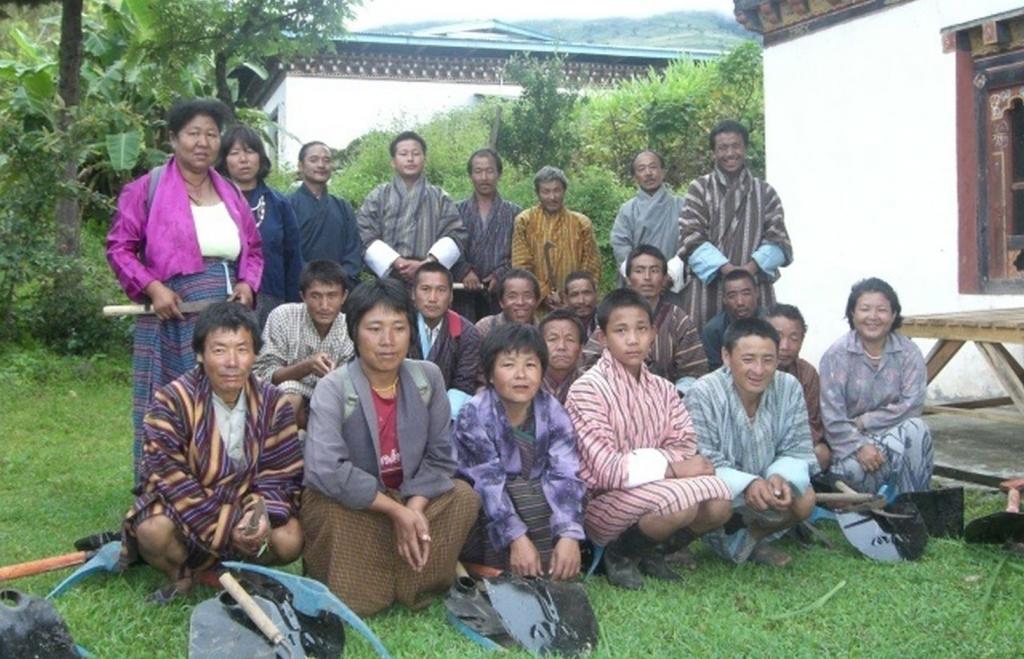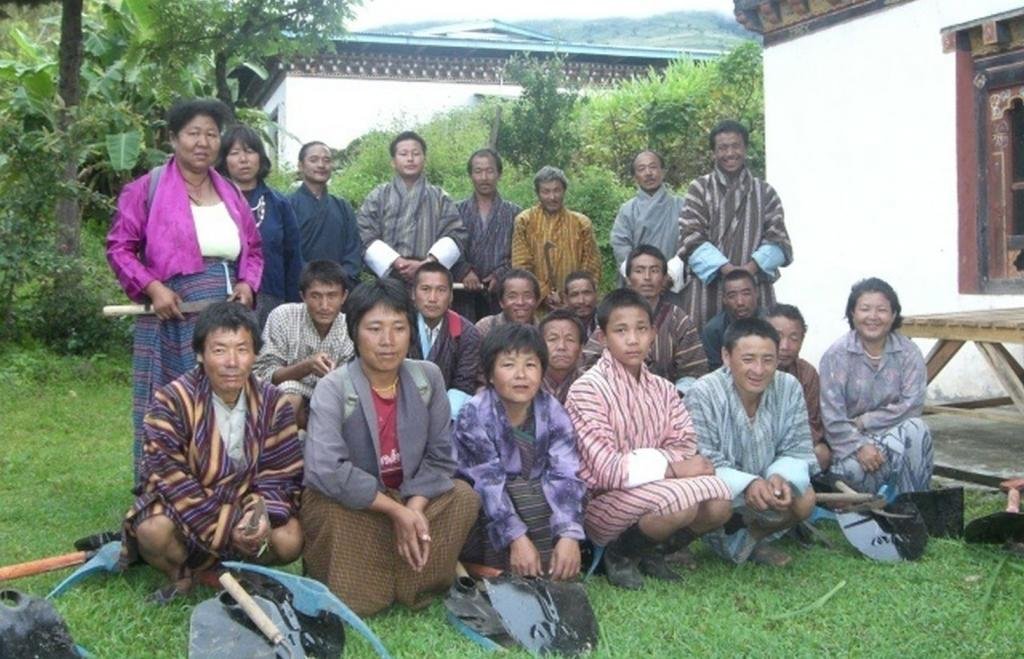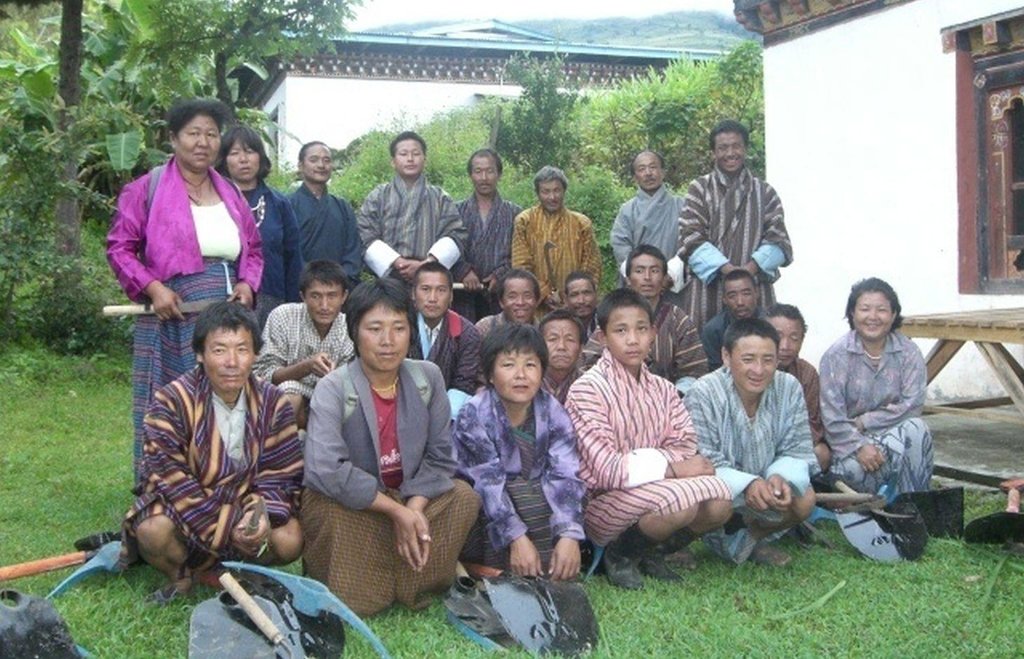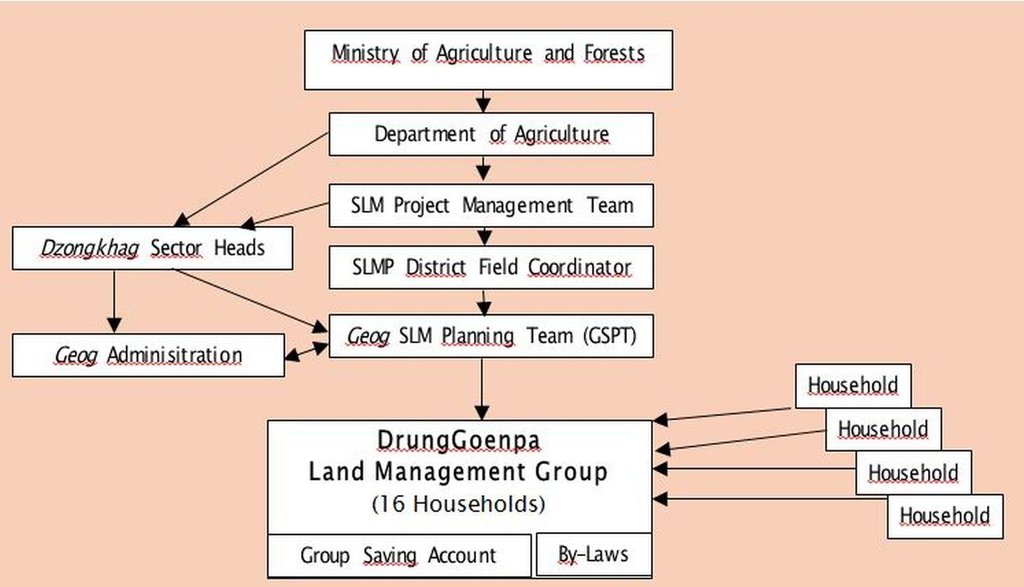Land Management Group [Bhutan]
- Creation:
- Update:
- Compiler: Karma Dorji
- Editor: –
- Reviewer: Fabian Ottiger
Phazhing Zinchung Tshogpha (Dzobgkha)
approaches_2493 - Bhutan
View sections
Expand all Collapse all1. General information
1.2 Contact details of resource persons and institutions involved in the assessment and documentation of the Approach
Name of the institution(s) which facilitated the documentation/ evaluation of the Approach (if relevant)
MoA (MoA) - BhutanName of the institution(s) which facilitated the documentation/ evaluation of the Approach (if relevant)
National Soil Services Centre (National Soil Services Centre) - Bhutan1.3 Conditions regarding the use of data documented through WOCAT
When were the data compiled (in the field)?
25/03/2011
The compiler and key resource person(s) accept the conditions regarding the use of data documented through WOCAT:
Yes
2. Description of the SLM Approach
2.1 Short description of the Approach
Land Management Group uniting all households in a community to plan and implement SLM and cash-generating activities
2.2 Detailed description of the Approach
Detailed description of the Approach:
Aims / objectives: A Land Management Group (LMG) unites all households of a village and aims to advocate, plan and implement SLM activities, based on the land-based issues of that particular community. The LMG has formal by-laws, drafted interactively with the community, and has its own group saving account, as access to credit and proper savings is still a real constraint in remote areas. A first LMG was started in 2008 in Drunggoenpa chiog in Radhi geog, Trashigang Dzongkhag, East-Bhutan. The idea for the LMG was based on pioneering work of the Renewable Natural Resource Research Centre Bajo, Wangdue Dzongkhag, in Salamji chiog, Dagana Dzongkhag.
Methods: In an effort to reinforce the social cohesion of communities and to improve the efficiency of planning for implementing SLM interventions, SLMP has initiated Land Management Groups. A LMG is considered very useful to overcome one of the main constraints of SLM implementation in Bhutan: labour-shortage. Many individual households have a growing lack of labour and therefore difficulties to implement labour-intensive SLM activities such as terracing, stone bunding or afforestation work.
Stages of implementation: LMGs are especially suitable for smaller communities, where households live relatively close to each other and have a good community bond. Instead of inter-acting with many individual households separately, the extension staff can also target their services, such as training programmes and technical guidance, to the group. The Drunggoenpa LMG was supported in their group formation process with regular meetings and took part in the annual participatory SLM action plan-ning for the chiog, identifying key land-based problems, their causes and possi-ble SLM interventions. Implementation of these SLM activities, such as grass strip establishment, stone check dam construction, group private forest establishment, vegetable production and tree and bamboo plantation, was carried out in a labour-sharing approach. Pooling labour in the group, all the land of the group members is converted or treated.
Role of stakeholders: This enables vulnerable families including single-headed households and the poorest-of-poor, to participate and get access to more labour-intensive SLM interventions. Apart from the pure SLM interventions, attention is given to cash-generating activities such as vegetable production and potato cultivation, to enhance the livelihoods of the farmers.
Other important information: Costs of forming a LMG including implementation of a series of SLM activities at the village level are limited(less than US$2,000 annually).
2.3 Photos of the Approach
2.5 Country/ region/ locations where the Approach has been applied
Country:
Bhutan
Further specification of location:
Trashigang Dzongkhag, Radhi geog, Drung Goempa Chiog
2.6 Dates of initiation and termination of the Approach
Indicate year of initiation:
2008
Year of termination (if Approach is no longer applied):
2012
2.7 Type of Approach
- project/ programme based
2.8 Main aims/ objectives of the Approach
The Approach focused mainly on SLM with other activities (vegetable production, potato production for cash income generation)
- To overcome labour constraints of labour-intensive SLM activities by working in a group, becoming more time-efficient
- To enhance the community bond and give access to all households to SLM activities
The SLM Approach addressed the following problems: - Severe land degradation in the village through landslides and surface erosion on very steep dryland
- Overgrazing by cattle, causing crop damage and forest degradation
- Lack of timber as result of forest degradation and deforestation
2.9 Conditions enabling or hindering implementation of the Technology/ Technologies applied under the Approach
social/ cultural/ religious norms and values
- hindering
Labour-intensive SLM activities are potentially excluding vulnerable households from access to SLM support
Treatment through the SLM Approach: Group approach enables the inclusion of all households, making use of labour-sharing
legal framework (land tenure, land and water use rights)
- enabling
The existing land ownership, land use rights / water rights greatly helped the approach implementation: All group members own land and this is a great help to implement SLM activities as there is a great sense of ownership.
workload, availability of manpower
- hindering
Labour-intensive character of some of the SLM interventions
Treatment through the SLM Approach: Labour-sharing approach in group eases constraint, even for vulnerable and single-headed households
3. Participation and roles of stakeholders involved
3.1 Stakeholders involved in the Approach and their roles
- local land users/ local communities
group with local by-laws
No gender bias; women are equally participating in more physically demanding activities, such as ploughing. Yes, little. All community households are participating in the land management group, including some female headed and poorest households.
- SLM specialists/ agricultural advisers
- local government
Local government (geog and chiog level)
- national government (planners, decision-makers)
If several stakeholders were involved, indicate lead agency:
Initial idea was developed after field visit by community members and Geog SLM Planning Team (GSPT) to Selamji Land Management group in Dagana Dzongkhag.
3.2 Involvement of local land users/ local communities in the different phases of the Approach
| Involvement of local land users/ local communities | Specify who was involved and describe activities | |
|---|---|---|
| initiation/ motivation | interactive | Community members were inspired by visit to Salamji, a SLM focal village in Dagana Dzongkhag and advocated a similar approach in their village |
| planning | interactive | Participatory SLM action planning, annually, to discuss land based issues, causes and potential SLM interventions |
| implementation | interactive | Range of SLM interventions such as grass strip establishment, stone check dam construction, group private forest plantation etc. technical guidance by local extension staff |
| monitoring/ evaluation | interactive | Participatory Monitoring & Evaluation meetings with geog extension staff and members of the municipality administration; includes regular insight in group saving account balance and status for transparency |
| Research | none |
3.3 Flow chart (if available)
Description:
Organisation chart of the Land Management Group
Author:
Hans van Noord (Schoutenkamp 43 Heteren The Netherlands)
3.4 Decision-making on the selection of SLM Technology/ Technologies
Specify who decided on the selection of the Technology/ Technologies to be implemented:
- mainly land users, supported by SLM specialists
Explain:
.Annual Participatory SLM Action Planning to discuss land-based issue, causes and interventions options and priorities.
Decisions on the method of implementing the SLM Technology were made by mainly by SLM specialists with consultation of land users. Mainly by SLM specialists with consultation of land users; consultation process in context of participatory SLM action planning and participatory monitoring and evaluation meetings.
4. Technical support, capacity building, and knowledge management
4.1 Capacity building/ training
Was training provided to land users/ other stakeholders?
Yes
Specify who was trained:
- land users
Form of training:
- on-the-job
- farmer-to-farmer
- public meetings
Subjects covered:
Training to community members on group formation and specific technical SLM interventions such as organic vegetable production, grass strip establishment, group private forestry, stone check dam construction, bamboo plantation etc. The annual participatory SLM action planning and natural resource mapping also contributed considerably in raising awareness of all villagers, developing their understanding of causal chain relations of their key land problems.
4.2 Advisory service
Do land users have access to an advisory service?
Yes
Specify whether advisory service is provided:
- on land users' fields
Describe/ comments:
Name of method used for advisory service: SLM advisory service by extension staff; Key elements: Grass strip establishment, Group formation, Organic vegatable Production; Renewable Natural Resource Extension staff of the geog are providing on-the-job advisory service to the group members through regular visits to the community to carry out trainings, which are mainly hands-on, with a demonstration site on the land of one of the group members. At the end of the training the group members plan for a rotation schedule to carry out the SLM activity on the land of all group members.
Advisory service is quite adequate to ensure the continuation of land conservation activities; Determination expressed by group to continue with activities post-project.
4.3 Institution strengthening (organizational development)
Have institutions been established or strengthened through the Approach?
- yes, greatly
Specify the level(s) at which institutions have been strengthened or established:
- local
Specify type of support:
- capacity building/ training
Give further details:
Considerable support to the Land Management Group through group formation process guidance and concentrated effort to plan for and implement a range of SLM focused activities, combined with hands-on training events.
4.4 Monitoring and evaluation
Is monitoring and evaluation part of the Approach?
Yes
Comments:
bio-physical aspects were regular monitored by project staff, land users through observations; indicators: Regular observations by project staff together with group members of grass strips, riser height, check dam infill and tree seedling growth
technical aspects were regular monitored by project staff, land users through observations; indicators: Regular observations and measurements by project staff together with group members of grass strip area, number of check dams and plantation status (bamboo and tree seedlings)
socio-cultural aspects were regular monitored by project staff, land users through observations; indicators: Regular observations by project staff together with group members on group status and feedback of group on implementation progress and issues and future activities
economic / production aspects were regular monitored by project staff, land users through observations; indicators: Regular observations by project staff together with group on crop yield, fodder grass production along grass strips (# of loads) and animal production increase (milk in litres, butter and cheese in kilos)
area treated aspects were ad hoc monitored by project staff, land users through measurements; indicators: Regular measurement by project staff and group members of area treated with grass strips and area planted with bamboo and tree seedlings
no. of land users involved aspects were ad hoc monitored by project staff, land users through observations; indicators: Ad-hoc observation by group members (attendance register)
management of Approach aspects were regular monitored by project staff, land users through observations; indicators: Regular observations in participatory monitoring and evaluation meetings with group members
There were few changes in the Approach as a result of monitoring and evaluation: In the initial group formation process these was considerable involvement by the local extension staff, which has been reduced as the group members have taken upon themselves most of the planning and implementation as their confidence levels have risen and their technical capability enhanced by a series of training events.
There were few changes in the Technology as a result of monitoring and evaluation
5. Financing and external material support
5.1 Annual budget for the SLM component of the Approach
If precise annual budget is not known, indicate range:
- < 2,000
Comments (e.g. main sources of funding/ major donors):
Approach costs were met by the following donors: international (GEF, World Bank): 85.0%; local community / land user(s) (Land Management Group): 15.0%
5.2 Financial/ material support provided to land users
Did land users receive financial/ material support for implementing the Technology/ Technologies?
Yes
5.3 Subsidies for specific inputs (including labour)
- equipment
| Specify which inputs were subsidised | To which extent | Specify subsidies |
|---|---|---|
| tools | partly financed | |
- agricultural
| Specify which inputs were subsidised | To which extent | Specify subsidies |
|---|---|---|
| seeds | fully financed | |
| Seedlings | fully financed | |
If labour by land users was a substantial input, was it:
- voluntary
Comments:
Labour contribution to the land management group is in principle voluntary, but for some of the specific SLM interventions SLMP pays the households a fixed amount per area converted or treated with grass strips, planted with bamboo rhizomes etc. These cash payments are an incentive to establish and start certain techniques for which considerable labour is required. All recurrent activities are carried out by the group members.
Tool sets are provided to the group, consisting of hand tools as pickaxe, crowbar and spade. Additionally, seeds and seedlings needed for SLM activities are provided free of cost by SLMP, such as bamboo rhizomes, tree seedlings, fruit tree seedlings, fencing material for the group private forest establishment and temperate grass seed mixture.
5.4 Credit
Was credit provided under the Approach for SLM activities?
No
6. Impact analysis and concluding statements
6.1 Impacts of the Approach
Did the Approach help land users to implement and maintain SLM Technologies?
- No
- Yes, little
- Yes, moderately
- Yes, greatly
Soil and water conservation efforts have improved considerably with at least o.5 ha of land converted to/treated with SLM, such as grass strips, stone check dams and bamboo and tree plantation areas. A visible impact has been made as the area of grass strips and developing bench terraces are visible for the whole municipality.
Did the Approach empower socially and economically disadvantaged groups?
- No
- Yes, little
- Yes, moderately
- Yes, greatly
The most vulnerable household are members of the group, representing the poorest families and female-headed households. Some of the hands-on trainings were carried out on the land of these households to give them first access and overcome their labour shortage constraint.
Did other land users / projects adopt the Approach?
- No
- Yes, little
- Yes, moderately
- Yes, greatly
Approach has been rolled out to other communities in Trashigang Dzongkhag to scaling-up municipalities of SLMP, based on the experiences with the Drung Goenpa Land Management Group
Did the Approach lead to improved livelihoods / human well-being?
- No
- Yes, little
- Yes, moderately
- Yes, greatly
Moderate improvement of livelihoods through improved vegetable production (now self-sufficiency and cash generating), stabilization of land degradation, better workability of cropland through grass strip and bench terrace development and improved animal production through improved fodder quality and availability. Also the workload has been reduced by collecting fodder through cut-and-carry near the farm from the grass strips, instead of having to walk far to the forest for fodder collection. The group approach is able to tackle the labour constraint faced previously and includes all vulnerable households.
Did the Approach help to alleviate poverty?
- No
- Yes, little
- Yes, moderately
- Yes, greatly
Considerable improvement in food self-sufficiency / security by vegetable production and increased yield on cropland treated with grass strips. Also clear improvement of animal production because of fodder improvement with the grass strips providing readily available quality fodder. Potato has now become a cash crop and some households sell vegetables, whereas they had to purchase in the recent past.
6.2 Main motivation of land users to implement SLM
- increased production
- increased profit(ability), improved cost-benefit-ratio
- reduced workload
- affiliation to movement/ project/ group/ networks
- environmental consciousness
- well-being and livelihoods improvement
6.3 Sustainability of Approach activities
Can the land users sustain what has been implemented through the Approach (without external support)?
- uncertain
If no or uncertain, specify and comment:
The group is expected to be able to sustain their activities independently, but a group process is always complex and there are no certainties looking forward. The improved sense of community bonding and mutual trust however is clearly expressed and essential for future sustainability of the group, supported by the existing group saving account, facilitating financial sustainability.
6.4 Strengths/ advantages of the Approach
| Strengths/ advantages/ opportunities in the land user’s view |
|---|
| Are equal.... |
| Strengths/ advantages/ opportunities in the compiler’s or other key resource person’s view |
|---|
|
Enhanced community bond and mutual trust Labour-sharing approach in group eases the difficulty to implement labour-intensive SLM activities Vegetable production in group has improved food security and generates cash income Saving account of group facilitates credit need of households and serves as common bond between households (How to sustain/ enhance this strength: Continued support and guidance to group Continue labour-sharing in future activities Increase production area Regular bookkeeping and cash generating activities to add to savings) |
6.5 Weaknesses/ disadvantages of the Approach and ways of overcoming them
| Weaknesses/ disadvantages/ risks in the land user’s view | How can they be overcome? |
|---|---|
| Are equal... |
| Weaknesses/ disadvantages/ risks in the compiler’s or other key resource person’s view | How can they be overcome? |
|---|---|
|
Initially freely grazing cattle caused problems between group members with implementation of SLM activities Group expresses interest in having a simple meeting venue to facilitate group meetings |
By-laws help to overcome issues and working together in a group has improved mutual trust Seek support to construct simple meeting hall |
7. References and links
7.1 Methods/ sources of information
- field visits, field surveys
- interviews with land users
Links and modules
Expand all Collapse allLinks
No links
Modules
No modules






